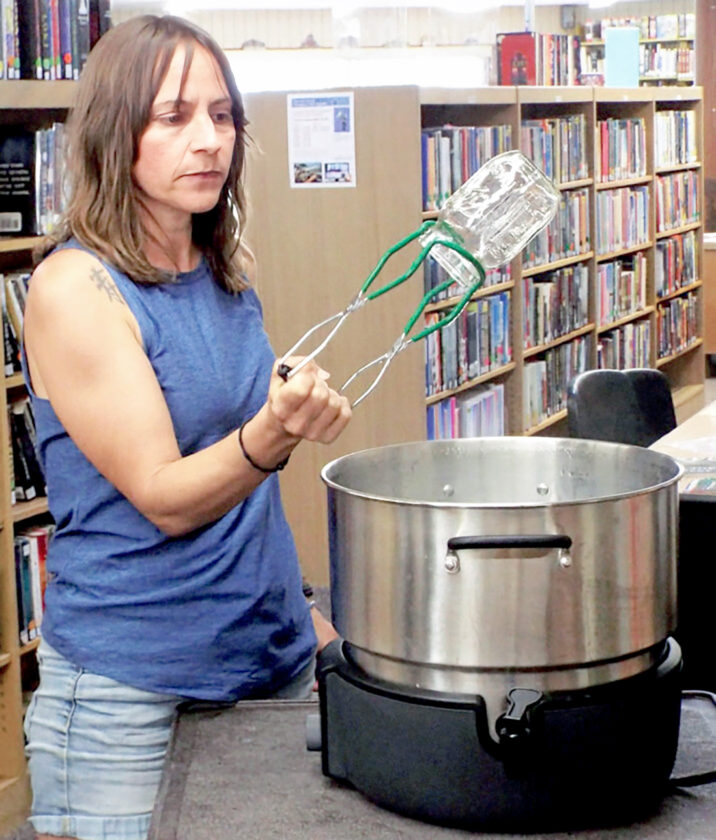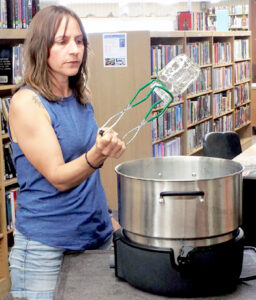Chester residents learn the art of water bath canning

CHECKING THE JAR — Arwen Niles, of Chester, pulls her jar of pickle slices from a water bath using a jar lifter Tuesday afternoon during a canning class at Lynn Murray Memorial Library in Chester. -- Stephanie Ujhelyi
CHESTER — When Connie Doughty, the director at Lynn Murray Memorial Library, walked into work Aug. 20, the lingering aroma of pickles greeted her.
The previous afternoon, the library was the site of a canning class offered by the WVU Hancock County Extension office that detailed the fine art of canning via water bath.
The class is a favorite of Extension Agent Zach White, who explained, “Home food preservation is not only a great way to enjoy your garden harvest all year long, but it also helps reduce food waste and ensures you know exactly what’s in the food you’re serving your family.”
Twelve people from West Virginia, Ohio and Pennsylvania attended and turned cucumbers into pickles through the canning process using the boiling water bath method.
Participants learned proper water bath canning procedures, safe food preparation and each were able to take home the pint jar of pickle slices canned in class.
White explained that although high-acid foods, such as tomatoes, can be canned in boiling water like the pickles, as one adds brine to the cucumber slices in the jar, low acid vegetables and products such as beef stew must be canned in a pressure canner.
Altitude also does play a role in your canning time, so he urged attendees to add extra time as Chester is 1,000 feet above sea level.
Jars should be cleaned in soapy water and kept hot before use to avoid breakage when they are filled with a hot product before being returned to the canner (once filled) for processing.
Any jars with nicks, cracks or rough edges should be discarded as they compromise the airtight seal, allowing food to spoil, White explained.
In the case of pressure canners, the extension agent discouraged use of pressure cookers as pressure canners, as they are not the same. “Canning can be a scary thing especially with pressure canning,” White said.
Larger than pressure cookers, pressure canners can hold more jars plus reach a higher PSI (pressure per square inch) than cookers to ensure the user is meeting safety guidelines associated with United States Department of Agriculture recipes.
Following directions when canning is key to allow for proper processing, explained White. “You can add time if needed but not take away.”
Some participants expressed concerns about their past canning habits upon learning the new information from White.
He also discussed the types of packing jars as part of the preparation. On Tuesday, participants utilized raw packing, slicing the cucumbers and inserting the raw vegetables into the canning jar before pouring in the hot brine liquid, allowing the appropriate half-inch of head room near the top (It is a quarter-inch for most jams and jellies) and screwing the lid on fingertip tight.
With hot packing, the food is cooked inserted in the jar and then the cooking liquid is poured in.
Jars need to be fully submerged in your cooking vessel with water to be properly processed.
Due to the popularity of Tuesday’s class, another session is pending at the library regarding the canning of jams and jellies. That date and time will be announced when set.



